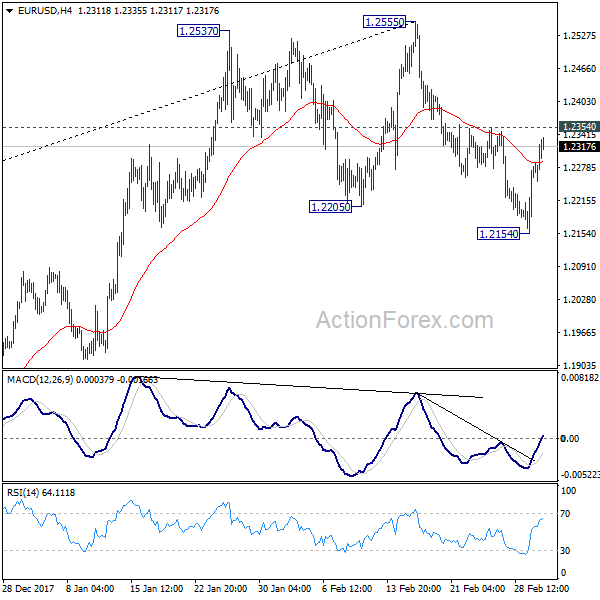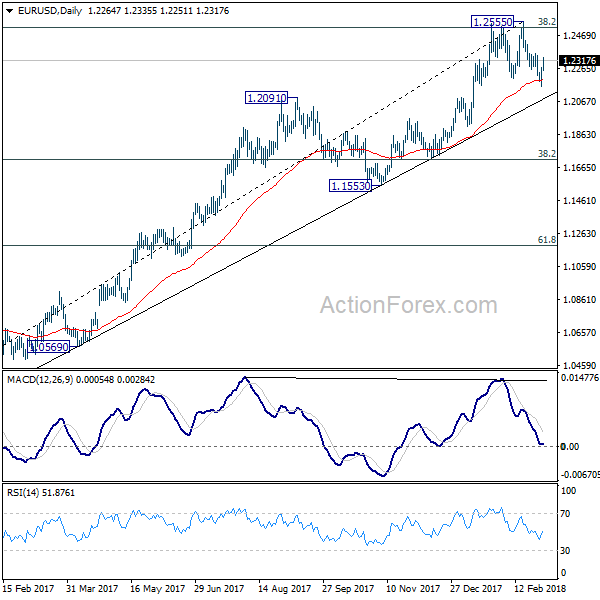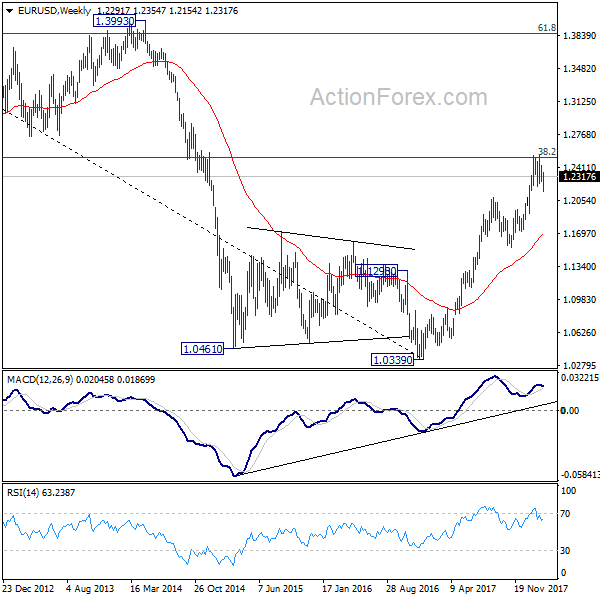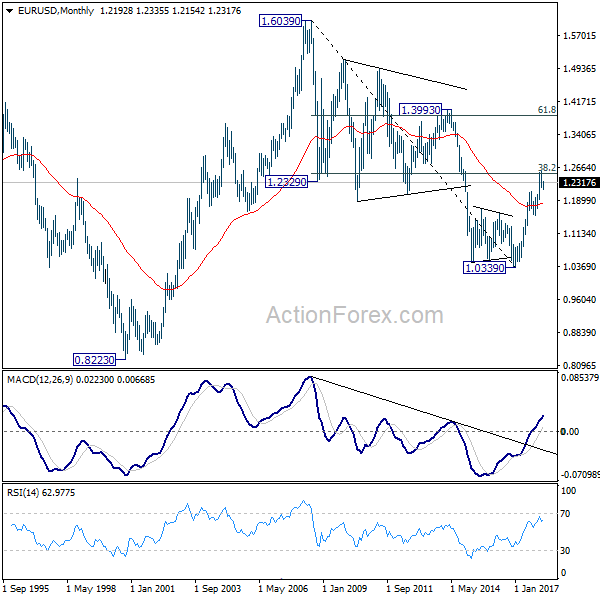The theme of trade wars overwhelmed the global financial markets last week and overshadowed any other topics. It started on news that US President Donald Trump is going to impose tariffs of 25% on steel and 10% on aluminum. Trump then doubled down by tweeting "trade wars are good, and easy to win" on Friday. DOW suffered a wild 1582 pts swing, diving from weekly high at 25800.35 to as low as 24217.76 before closing at 24538.06. Dollar was initially boosted by Fed Chair Jerome Powell’s testimony, which raised the chance of four Fed hikes this year. But the greenback gave up after a brief try to reverse its down trends against Euro and Swiss Franc. Sterling was pressured as EU’s draft Brexit treaty reminded the markets that there are still huge divergences between UK and EU regarding post Brexit relationship. And UK Prime Minister Theresa May’s high profile speech on Friday didn’t live up to the expectations and gave no inspirations.
In the currency markets, Yen ended as the strongest one on risk aversion. Euro closely followed as the second. Dollar didn’t perform too badly indeed as it end as the third strongest. Meanwhile, Canadian Dollar ended as the weakest one, partly because of ongoing drag in NAFTA renegotiation, and partly because it’s the biggest steel importer to the US. Sterling followed as the second weakest while Aussie was the third.
Large volatility in the markets is almost like a guarantee in the coming week. Results of German Social Democrat member’s vote on grand coalition will be released on Sunday. Italy election will be held on the same day too. Then, Trump will probably formally announce the tariffs and other countries will have likely come up with counter measures. Then, there will be RBA, BoC, BoJ and ECB rate decision. US will also release non-farm payroll report. We better be prepared for a rough ride.
DOW heading through 23360 and below as medium term correction extends
DOW initially edged higher to 25800.35 last week but reversed from there and dropped sharply to as low as 24217.76. The index then recovered to close at 24538.06. The development now suggests that the corrective pattern from 26616.71 has started the third leg. That is, further fall should be see through 23360.29 in near term to 100% projection of 16616.71 to 23360.29 from 25800.35 at 22543.93.
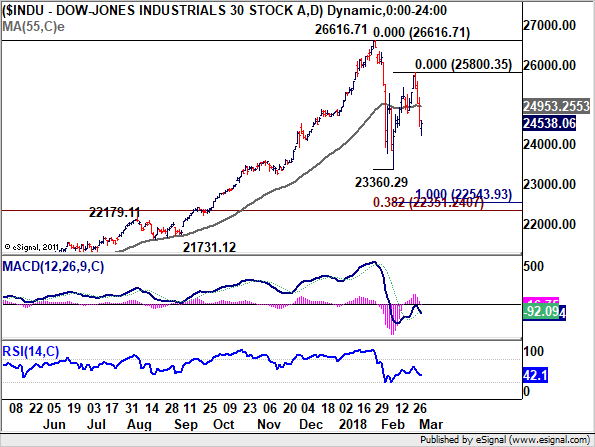
Nonetheless, the goods news is that for now, it’s look like DOW is only corrective the up trend from 15450.56. Therefore, strong support should be seen around above mentioned 22543.93, which is close to 55 week EMA (now at 22817.61), and 38.2% retracement of 15450.56 to 26616.71 at 22351.24, to bring strong, sustainable rebound.
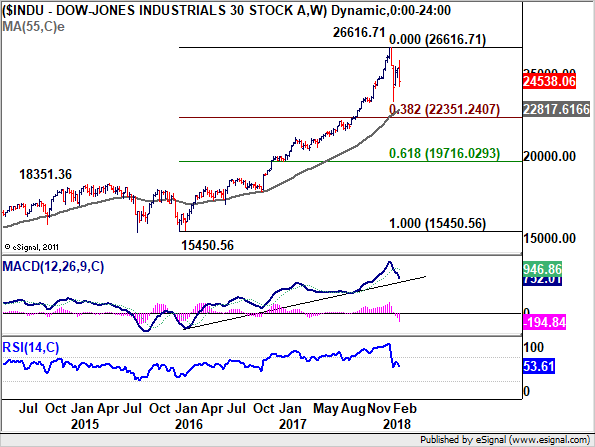
German DAX performing even worse
Outlook of German DAX is much worse as the last week’s sharp decline to close at 11913.71 confirmed resumption of fall form 13596.89. Based on current momentum, key support level at 11868.85 will likely be taken out firmly. And DAX would dive to 61.8% retracement of 9214.09 to 13596.89 at 10888.32 before having strong enough support for rebound.
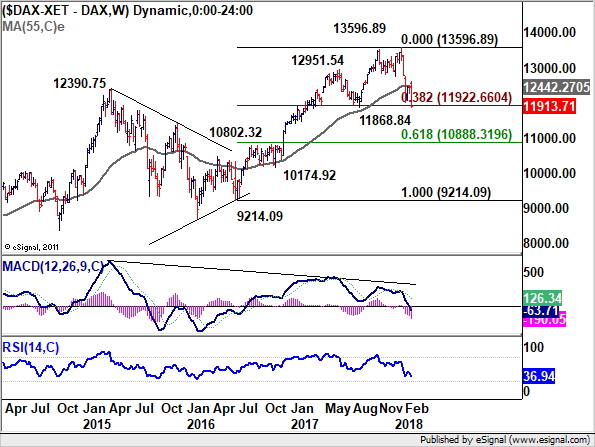
10 year yield takes a breath, but still on course for 3.036
Despite increasing expectation for four Fed hikes this year, 10 year yield didn’t extend recent up trend. For now, 2.943 should be a short term top. And TNX will likely gyrate lower as correction, possibly to 55 day EMA (now at 2.690). But we’d expect strong support from 38.2% retracement of 2.033 to 2.943 at 2.595 to bring rebound.
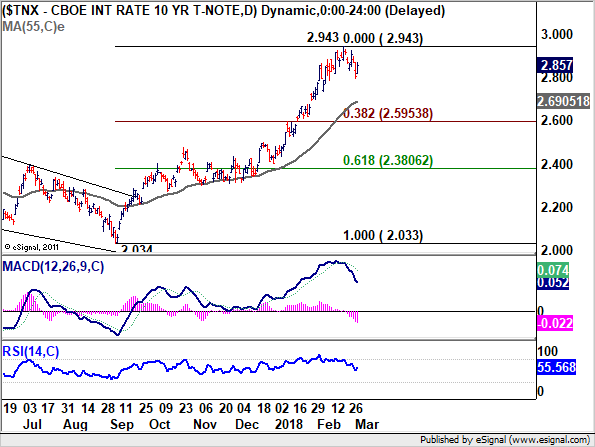
We’d maintain then the region between 3.036 and 3.318 (100% projection of 1.336 to 2.621 from 2.034) is the long term trend defining resistance zone. And TNX should at least have a go at it even if it’s going to give up eventually.
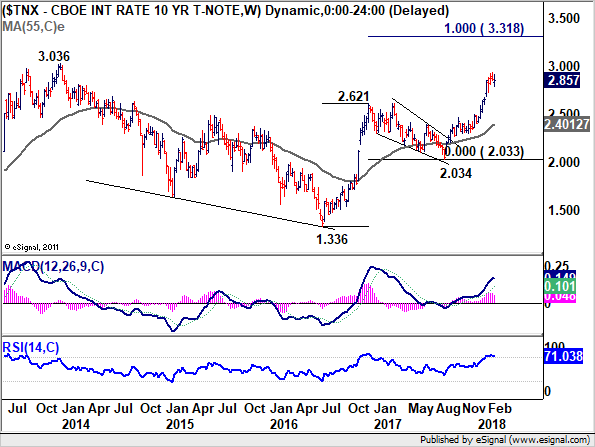
Dollar index staying in down trend after failing 91.01 key resistance
For once, Dollar looks like it’s finally reversing the down trend as inspired by Fed Chair Jerome Powell’s testimony. However, it clearly lacked follow through buying to push it through 91.01 key support turned resistance. For now, it’s staying in the down trend from 103.82. And more downside is still in favor to key support at 84.75 (61.8% retracement of 72.69 to 103.82 at 84.58) before having enough support to complete the medium term correction.
Again, firm break of 91.01 will be the first signal of trend reversal and will turn focus back to 95.15 key resistance for confirmation.
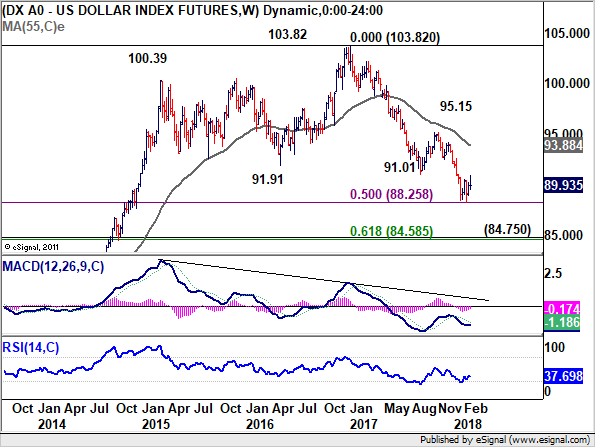
EUR/USD Weekly Outlook
EUR/USD dipped 1.2154 last week but drew support from 55 day EMA and rebounded. The failure to sustain below 1.2205 key support didn’t confirm trend reversal. Initial bias is neutral this week first. on the upside, above 1.2354 minor resistance will bring retest of 1.2555 high. Firm break there will carry larger bullish implication. On the downside, break of 1.2154 would revive the case of rejection by 1.2516 key fibonacci level and trend reversal. Outlook will be turned bearish for 38.2% retracement of 1.0339 to 1.2555 at 1.1708.
In the bigger picture, key fibonacci level at 38.2% retracement of 1.6039 (2008 high) to 1.0339 (2017 low) at 1.2516 remains intact despite attempts to break. Hence, rise from 1.0339 medium term bottom is still seen as a corrective move for the moment. Rejection from 1.2516 will maintain long term bearish outlook and keep the case for retesting 1.0039 alive. Firm break of 1.1553 support will add more medium term bearishness. However, sustained break of 1.2516 will carry larger bullish implication and target 61.8% retracement of 1.6039 to 1.0339 at 1.3862.
In the long term picture, 1.0339 is seen as an important bottom as the down trend from 1.6039 (2008 high) could have completed. It’s still early to decide whether price action from 1.0339 is developing into a corrective or impulsive pattern. Reaction to 38.2% retracement of 1.6039 to 1.0339 at 1.2516 will give important clue to the underlying momentum.
